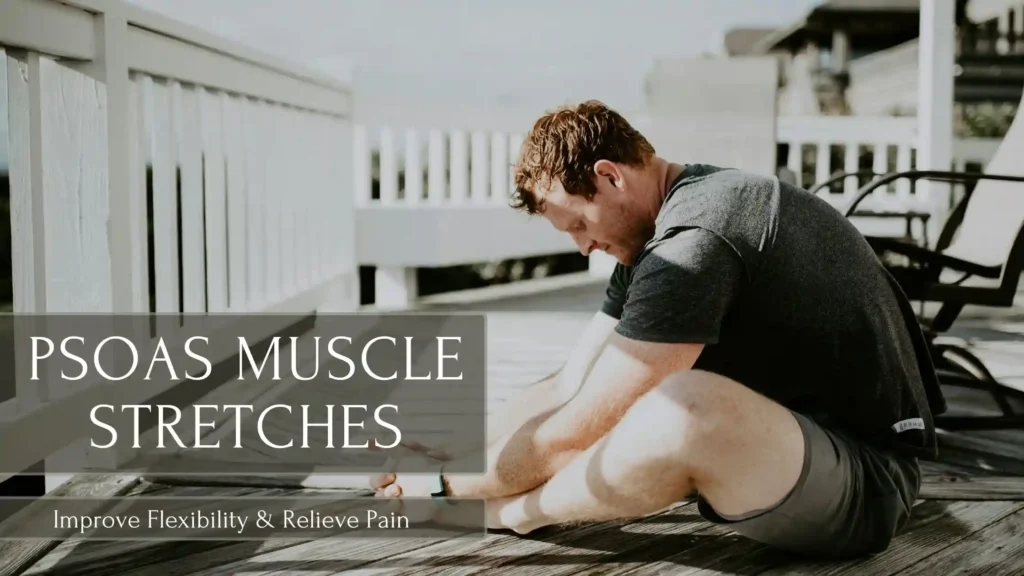The psoas muscle plays a crucial role in posture, movement, and overall well-being. However, it often becomes tight due to prolonged sitting, stress, or intense physical activity. Whether you’re an athlete, desk worker, or someone experiencing psoas muscle pain, incorporating effective psoas muscle stretches into your routine can significantly enhance flexibility and reduce discomfort.
In this guide, we’ll cover how to stretch the psoas muscle, signs of tightness, and the best psoas muscle exercises to improve mobility and relieve pain.
Understanding Psoas Muscle Stretches: Taking Control of Your Well-Being
The psoas muscle (pronounced “SO-as”) is a deep-seated core muscle that connects the lower spine to the femur. It’s one of the primary hip flexors responsible for walking, running, and sitting. Despite its importance, the psoas is often neglected—leading to stiffness, pain, and postural imbalances.
Why Does the Psoas Get Tight?
A tight psoas muscle can result from:
- Prolonged sitting · Shortens and weakens the muscle.
- Lack of stretching · Reduces mobility and flexibility.
- Stress and tension · The psoas is linked to the body’s “fight-or-flight” response, tightening under stress.
- Overuse · Intense workouts without proper recovery can lead to stiffness.
Best Psoas Muscle Stretches
To effectively release the psoas muscle, try these proven stretches:
1. Low Lunge Stretch
This classic stretch lengthens the psoas muscle while improving hip flexibility.
- Step into a lunge with your right foot forward and left knee on the ground.
- Shift your hips forward slightly to feel a stretch in the left hip.
- Hold for 20–30 seconds, then switch sides.
Tip: Keep your torso upright and avoid leaning too far forward.
2. Reclining Psoas Stretch
A gentle stretch to relieve tension in the psoas muscle while lying down.
- Lie on your back with both legs extended.
- Pull your right knee toward your chest, keeping the left leg straight.
- Hold for 30 seconds, then switch sides.
Tip: Use a yoga strap around your foot for extra support.
3. Bridge Pose
This yoga pose strengthens and stretches the psoas muscle simultaneously.
- Lie on your back, knees bent, feet flat on the floor.
- Press through your heels and lift your hips toward the ceiling.
- Hold for 10–15 seconds, then lower slowly.
Tip: Engage your glutes for extra stability.
4. Supine Psoas Release
This technique uses a foam roller for passive psoas muscle release.
- Lie on your back with a foam roller positioned under your lower back.
- Relax and let gravity stretch the psoas.
- Hold for 1–2 minutes, then switch sides.
Tip: Take deep breaths to enhance the release.
5. Seated Butterfly Stretch
Targets the psoas muscle and inner thighs for a deep stretch.
- Sit with the soles of your feet together, knees bent outward.
- Gently press your knees toward the floor with your elbows.
- Hold for 20–30 seconds.
Tip: If your hips are tight, sit on a cushion for extra support.
How to Stretch the Psoas Muscle Effectively
To get the most out of your psoas muscle stretches, follow these tips:
- Warm up first · A short warm-up increases blood flow to the psoas.
- Breathe deeply · Helps release tension more effectively.
- Be consistent · Stretch daily, especially if you sit for long hours.
- Listen to your body · Avoid forcing a stretch into pain.
Common Mistakes to Avoid
- Overstretching · Can cause injury; ease into stretches.
- Poor form · Maintain a neutral spine for effective stretching.
- Ignoring muscle balance · Strengthen your core and glutes alongside stretching.
Incorporating Psoas Stretches Into Your Daily Routine
Adding psoas muscle exercises to your routine doesn’t have to be complicated:
- Morning routine · Start the day with a low lunge stretch.
- Desk breaks · Take 5-minute stretch breaks if you sit for long hours.
- Post-workout · Use supine psoas release to relax after training.
- Evening wind-down · Reclining psoas stretches help you unwind before bed.
Final Thoughts
Maintaining a healthy psoas muscle is essential for mobility, posture, and pain relief. Whether you struggle with psoas muscle pain or want to enhance flexibility, incorporating psoas muscle stretches into your daily routine can make a huge difference. Start with these stretches, be consistent, and enjoy improved movement and reduced tension.
FAQ
What happens when the psoas muscle is tight?
A tight psoas muscle can cause lower back pain, hip stiffness, and postural issues. It may also contribute to stress and anxiety.
How often should I stretch my psoas muscle?
For best results, stretch the psoas muscle daily, especially if you sit for long hours.
Can stretching the psoas muscle relieve back pain?
Yes, psoas muscle stretches can help by improving spinal alignment and reducing tension.
Is it safe for beginners to stretch the psoas?
Absolutely! Start with gentle psoas muscle release techniques and progress to deeper stretches as flexibility improves.
Can stress impact the psoas muscle?
Yes, chronic stress can cause the psoas muscle to tighten, leading to discomfort and tension. Stretching and deep breathing can help release it.

